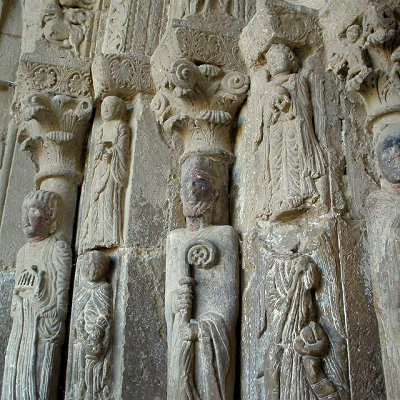
Like us on Facebook
PLACE NAMES




|
|
Sos del Rey Catolico
|

|
|
The location of this town, at an rocky elevation of terrain made it long a stronghold and from year 907 that was reconquested by Sancho I of Pamplona, had great importance as a border town.
It was incorporated in 1044 by Ramiro I to the Kingdom of Aragon.
In year 1452, during the War of Navarre, Queen Juana Enriquez moved to what was then the called "Sos" (town's previous name), where she gave birth to the infante Ferdinand on March 10, 1452, who later became in Ferdinand II of Aragon, one of the Catholic Monarchs. That birth added the tagline of "d'o Rei Catolico" to the name of the town.
In 1711 it was named as the capital of the Cinco Villas.
Main sightsinclude:
The exceptional preservation of the historic center makes a stroll around this town becomes a journey into the past highlighting the city walls, churches, Plaza de la Villa and the Palacio de los Sada, where Ferdinand was born in 1452.
- Castillo de Sos de Aragon, in a inside light promontory rise this castle built by Ramiro II of Aragon in 12th century, with further reforms. Has irregular plant, with a bucket provided with arrow slits and in the center, the most remarkable vestige that has been preserved of the 12th c. castle is the slender tower of homage, a square of 6 m side and topped by battlements, point from which the Pyrenean peaks can be seen, both Huescan as Navarrese. Previously to this it was in the same site a primitive wooden castle which were built around the houses, indeed that was the origin of the town. Of the original wooden castle nothing remains. As construction techniques evolved, the wood was replaced by stone.
- Palacio de los Sada, this palace dates from late 15th century, in Gothic style, and reformed in 16th and 17th centuries. It was built on the ruins of an previous castle and belonged to the Sada family from the French Provence. Here it was where Queen Juana Enriquez gave birth to the infante Ferdinand. Its façade has oval doors, coats of arms and shot of battlements. It preserves the courtyard and remains of the walls and a fortified tower. But all interior of this building is new. Today beside the tourist office can find a museum and interpretive center of the monarch.
- Barrio judío (the Jewish quarter) had great importance during the medieval era, in it lived about 30 families who came to the village in the 12th century and had to migrate to the neighboring Kingdom of Navarre in 1492, date on which the Catholic Monarchs signed the decree expelling the Jews of the kingdom of Castile and Aragon. At the heart of the district is the known as Plaza de la Sarten and where it can see in one of its houses a slot where formerly the Jews placed the Mezuzah, a scroll which has written two verses from the Torah and is usually found in the right of all the Jewish houses. In the Jewish quarter also is located the Old Synagogue, today converted into a farmhouse. It can also see that there is a cross drawn on the walls of some doors, it has been determined that these houses belong to Jews converted to Christianity, to record carved this symbol at the entrance.
- City Walls, The town of Sos is located on a rocky spur and is surrounded by the Gothic walls, which are confused in some parts with buildings. Of which seven city gates are preserved:
- City Gates, the nature of border town between the neighboring kingdoms of Navarre and Aragon, made the medieval town has a defensive wall around the entire perimeter of the town. Are seven tower-shaped city gates of the walls, giving access to the intramural enclosure are preserved today.
- Portal de Zaragoza, It gives the main access, to Calle Fernando el Catolico leading to Plaza de la villa.
- Portal de la Reina, called with this name, because according to tradition probably entered Queen Juana Enriquez from Navarre. This fortified tower has several loopholes windows and a machicolation and one of the stones of its gateway can see an inscription that made the soldiers of the Napoleonic French troops stationed in the town during the Peninsular War, which says "Merde pour les volantiers de Mina" that can be translated into English would mean "Shit to the volunteers of Mina" referring to the Espoz y Mina's Navarrese troops.
- Portal de Sanguesa.
- Portal de Jaca.
- Portal de Uncastillo.
- Portal de Bueno, this preserve only the arch with keystones..
- Portal de El Mudo, of pointed arch.
- Plaza de la Villa (square and Medieval market), one of the Sos's most important places. On the one hand it find a portico where the weekly market was held during the Middle Ages and where stands a triangular hollow popularly known as "el quesito" in this site the market's officer or almutafaz placed the "romana", a scale for weighing products and thus prevent merchants deceive buyers. Right next to the triangle the "barra jaquesa" was placed, a measure of length used in this part of Aragon, exactly 772 millimeters and that all merchants could use to verify the length of fabrics, yarns or textiles they bought.
- Casa de la Villa, (town hall), a Renaissance building from late 16th century, renovated in 19th century, and restored to adapt to its current role as administrative headquarters of the municipal offices, in the 1980's. in which highlights the town's coat of arms located on the front door and an inscription, of year 1681, on the right side of it where it can read "Dice Dios nuestro señor, en la casa del que jura no faltara desventura" (says God our Lord, in the house of who oath will not lack misfortune). The city hall has four floors, the main is believed to have been destined for the horses and local prison and the other three for administrative and justice functions. The courtyard has a special floor made up of a mosaic of pebbles, characteristic of the nobility constructions. The third floor has a gallery of small arches, typical of the Aragonese palaces.
- Colegio Isidoro Gil de Jaz, it can not visit as it is still in operation. Architect Don Isidoro Gil de Jaz was one of the ministers of King Charles III. During his childhood his family moved to the town of Sos, so it was here that his initial training began. For this reason, he always had a very special relationship with the municipality, in the mid-18th century he encouraged the creation of the Pious Schools for the children of Sos, on the site of the architect's house, expanding the space with some adjoining houses. Currently the building still houses the public school of the town for cycles for nursery and primary education, the Nature and Mentor classrooms. The building is located in Plaza de la Villa. The set includes the iglesia de San José de Calasanz.
- Loncha Medieval, is located next to the City Hall, it was built around the 15th century to house the large market and as a meeting place of the council of the town. Are still preserved the underground cistern, two water wells that were used as refrigerators and some crevices where the wine and oil jars were placed. Until a few years ago, in this recint was held one of the most important cultural fiestas of Aragon, the Festival Luna Lunera finally passed away due to financial problems. Today houses the municipal library in the main building.
- Iglesia de San Esteban, this Romanesque church was started to build in 13th century. It is in top of the town and attached to a tower. The tunnel that connects the crypt with the church, built in 11th century and used as a burial site, which can be seen about 22 sepulchers are marked with a cross. It can access the church for the 12th century great Romanesque portal which features a Pantocrator surrounded by the four evangelists represented as Tetramorph. In the interior highlights the 8th century baptismal font, the Romanesque christ Cristo del Perdón which according to a church legend helped a woman to forgive the murderer of her son, and the recently restored Rococo organ. Inside it is strictly forbidden to take pictures.
- Crypt of Santa Maria del Perdon, built in 1056 with donations of the Navarrese Queen Stephanie, Queen of Navarre. It has three small chapels decorated with frescoes depicting the life of Christ but are in very bad condition, in the crypt are two capitals made by Master Esteban, one of the architects of the Cathedral of Santiago de Compostela. Also inside is the 12th century virgin Virgen del Perdon.
- Iglesia de San Martín de Tours, it was the chapel of the primitive castle on that settled the Palacio de los Sada. Of Proto-Gothic style, built in 13th century, consists of a rectangular nave and apse, wooden roof over pointed arches and preserves Gothic murals in the apse.
- Palacio Español de Niño, this building is in Renaissance style and was built as the nobility palace of the Español de niño of the late 16th century.
- The Parador de Turismo.
- Ermita de Santa Lucia, it is a small church located outside the city walls. Built in the late-12th century or early-13th century. The façade of the church is simple. Originally, it was consecrated to Saint Michael, whom he referred to by the Gothic mural paintings preserved in the apse. Currently, the hermitage is visited on the Saint Lucia's day (December 13), before or after the offices held there.
- Palacio del Consistorio, an example of 16th century Aragonese civil architecture.
- Historic center, all the historic center is well preserved and the town is declared Historic-Artistic grouping and Bien de Interes Cultural in the year 1968.
- Monasterio e iglesia de Valentuñana, built by the Discalced Carmelites at the end of 17th century, is located about 2 kilometers from the town. It store a collection of overseas's pieces from the missions of Augustinians.
 Feel free to Email me any additions or corrections Feel free to Email me any additions or corrections
LINKS AVAILABLE TO YOUR SITE
| | |





